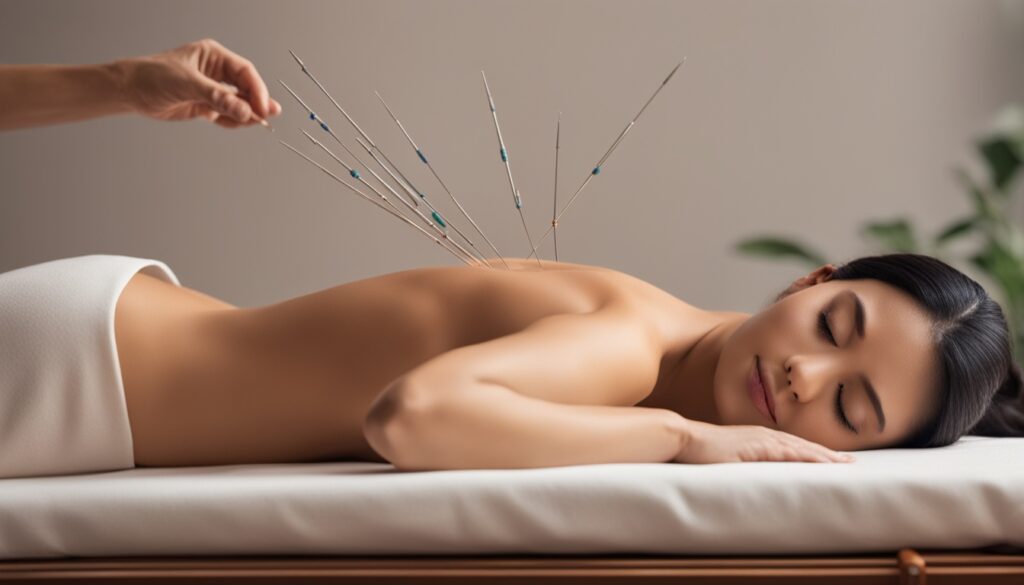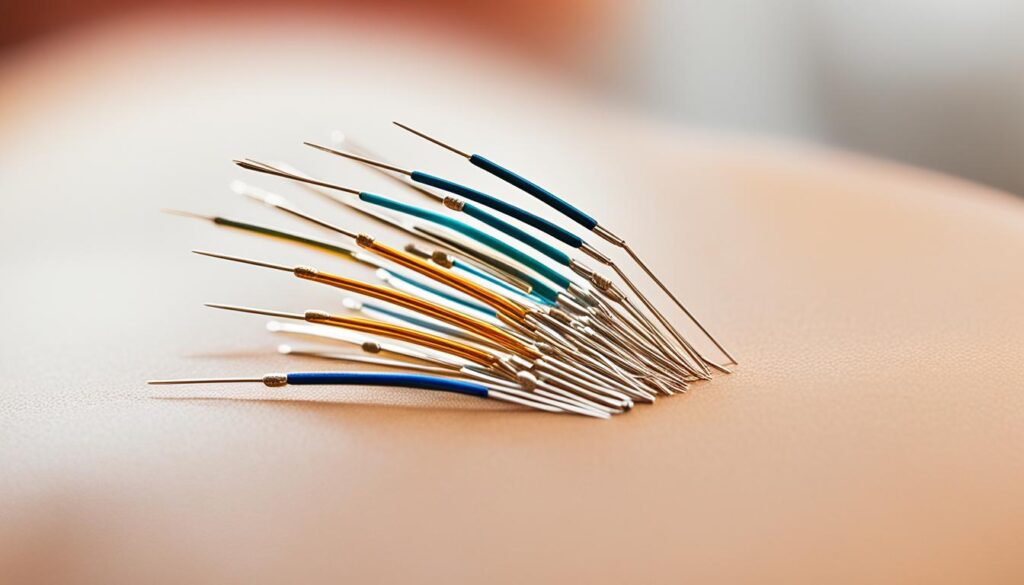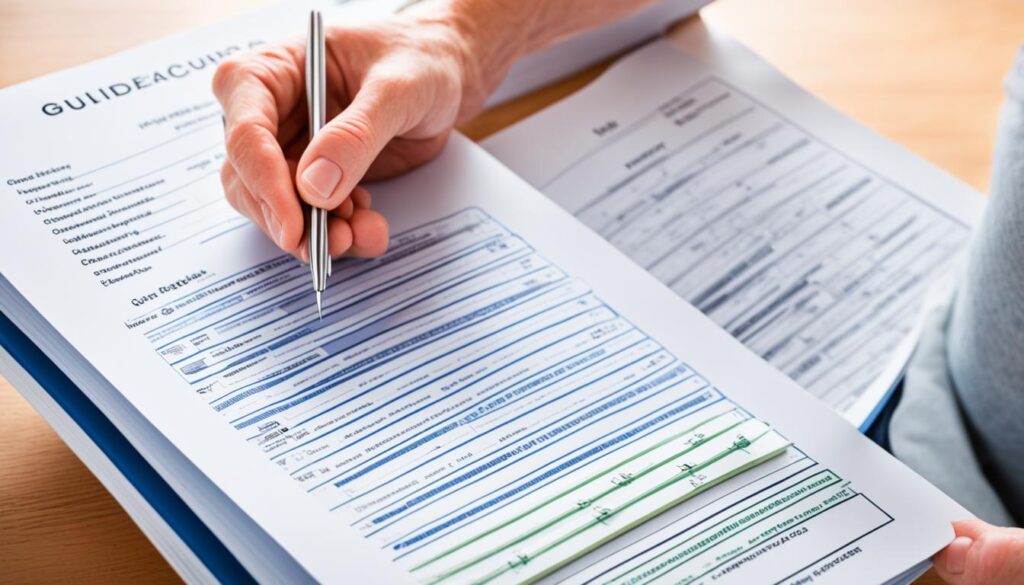Acupuncture is an ancient method from traditional Chinese medicine. It helps with pain relief and boosting wellness. Thin needles are inserted at specific points on your body. This helps energy flow better and brings balance. It is safe and works well with other medical treatments.
Its main benefit is relieving pain. It can help with chronic headaches, back pain, and more. By pinpointing these specific points, acupuncture releases endorphins and cuts down on swelling. This kind of relief is great if you don’t want to use drugs.
Besides easing pain, acupuncture helps with your overall health. It makes you feel more relaxed, less stressed, and sleep better. It balances your energy and promotes well-being. Many feel like it’s both peaceful and re-energizing.
Key Takeaways:
- Acupuncture is an ancient practice that involves the insertion of thin needles at specific points on the body.
- One of the main benefits of acupuncture is its ability to provide pain relief for conditions such as headaches, migraines, lower back pain, neck pain, and osteoarthritis.
- Acupuncture can also help manage stress, improve sleep quality, and promote relaxation.
- The practice of acupuncture aims to stimulate the flow of energy and restore balance in the body.
- It is important to consult with a qualified practitioner to ensure safe and effective acupuncture treatment.
How Does Acupuncture Work?
Acupuncture comes from traditional Chinese medicine. It’s all about restoring the body’s natural energy balance, known as qi. Through placing fine needles at specific points, along the body’s meridians, it helps energy flow better. This, in turn, boosts overall health and wellness.
From the viewpoint of Western medicine, acupuncture works by waking up the central nervous system. This leads to the body making its own natural chemicals. These chemicals help heal and ease pain. When needles are placed at certain points, it can affect how the body deals with pain and increase blood flow to those areas.
The practice of acupuncture is rooted in the belief that maintaining a harmonious energy flow is crucial for physical and emotional well-being.
When needles are inserted, they awaken the body’s senses. These signals travel to the brain and spine. The body then releases endorphins, which are pain fighters, and messengers that calm swelling and help fix tissues. Acupuncturists choose their points carefully. Their goal is to get the body’s natural healing to kick in.
A Holistic Approach to Healing
Acupuncture is not only for easing pain. It treats many health problems by looking for and fixing energy imbalances. It sees the body as a whole, combining physical and mental health. This is a key part of traditional Chinese medicine’s way of thinking.
Through pinpointing certain points, acupuncturists work to balance the body’s energy. This can boost health and energy. Even though we’re still learning about how acupuncture really works, it’s proven to help with many issues. These include pain, migraines, trouble sleeping, getting pregnant, and problems with digestion.
A Fusion of Ancient Wisdom and Modern Science
Acupuncture is getting more popular in the West. People are studying how it works in order to better understand its benefits. By blending ancient Chinese wisdom with what we know from science today, acupuncture is a powerful way to offer care.
| Traditional Chinese Medicine Perspective | Western Medicine Perspective |
|---|---|
| Energy flow (qi) through meridians | Central nervous system stimulation |
| Restore balance and harmony | Release of natural healing chemicals |
| Target specific acupuncture points | Influence pain processing and blood flow |
Research into acupuncture is ongoing. It’s leading to more and more use in healthcare. By joining ancient wisdom with new science, acupuncture is a great, all-around way to heal. It’s focused on balance and well-being for everyone.
Conditions That Acupuncture Can Help With
Acupuncture is a helpful treatment for many conditions. It can aid in pain relief and boost general health. This method takes a whole body approach to help you heal.
It’s useful for various health issues, like:
- Chemotherapy-induced and postoperative nausea and vomiting
- Dental pain
- Fibromyalgia
- Menstrual cramps
- Respiratory disorders
- Tennis elbow
Moreover, acupuncture is great for managing stress and keeping you well. It works by bringing balance and harmony to your body.
During acupuncture, fine needles are placed at key points. This triggers your body’s own recovery processes. As a result, it can help with many ailments mentioned.

The Process of Acupuncture
During acupuncture, thin needles are inserted into particular body points. This is done carefully and precisely to be as effective as possible. The insertion may cause a slight pressure or ache that quickly fades.
The acupuncturist sometimes spins or moves the needles after placing them. This action boosts the treatment’s effects by regulating energy flow. They might also add heat or small electric currents to the needles.
“The hands-on approach of needle manipulation allows the acupuncturist to customize the treatment to each individual’s needs and condition.”
Following this, needles stay in place for 10 to 15 minutes. The patient often feels deeply relaxed during this time. The acupuncturist keeps an eye on the patient’s reactions and may tweak the treatment as needed.
Removing the needles is often as simple as their placement. It’s quick, painless, and the patient may feel a burst of energy afterward. They might also feel peaceful and calm.
Acupuncture is a gentle practice focused on rebalancing and healing. Done by skilled hands, it’s safe and beneficial. The combination of needle work, manipulation, and their removal leads to a successful session.

| Key Elements of the Acupuncture Process | Description |
|---|---|
| Acupuncture Procedure | The process of inserting thin needles into specific points on the body to stimulate the flow of energy. |
| Acupuncture Session | The duration of time during which the acupuncture procedure is performed. |
| Needle Insertion | Carefully placing thin needles into acupuncture points on the body. |
| Needle Manipulation | Gently moving or twirling the needles to enhance their therapeutic effects. |
| Needle Removal | Painlessly taking out the needles from the acupuncture points at the end of the session. |
Risks and Safety of Acupuncture
Thinking about acupuncture can raise safety concerns. But, in the hands of a certified expert using clean needles, the risks are low.
Acupuncture is safe and not too invasive. Yet, it can cause light soreness, small bleeding, or bruising where needles go in. These effects are brief and get better quickly.
“Acupuncture is a widely accepted and safe form of therapy when performed by a trained and skilled acupuncturist using sterile needles.”
The use of disposable needles has made infections very rare. Every patient gets a new, clean needle. This method makes treatment areas safer.
But, acupuncture isn’t for everyone. People with pacemakers or who are pregnant need to be careful. They should talk to the acupuncturist about their health first. The acupuncturist will make sure the treatment plan is safe and effective.
Key Points:
- Acupuncture is generally safe under skilled experts.
- It might cause mild soreness, slight bleeding, or bruising.
- Using disposable needles lowers the infection risk.
- Not all people should have acupuncture, notably those with pacemakers or pregnant women.
- Always share health conditions with the acupuncturist beforehand.
Acupuncture stands as a trustworthy therapy when done right. It works best with clean needles and a plan tailored to each person. Sharing your health status ensures safe and effective care.
Choosing an Acupuncture Practitioner
When you look for an acupuncture practitioner, picking someone well-qualified and reliable is key. Below are tips to guide you in selecting the best acupuncturist for your situation:
- Ask for recommendations: Your friends, family, or doctors might point you to someone good. They can share their experiences and suggest who you should see.
- Check credentials: Make sure the acupuncturist has the right certifications. They should have passed an exam by the National Certification Commission for Acupuncture and Oriental Medicine (NCCAOM).
- Interview the practitioner: A first meeting can tell you a lot. Ask about their training, experience, and how they approach treatments. Share what you hope to achieve and see if they understand and can help.
- Discuss treatment plans and success rates: Learn about your treatment plan and what kind of results to expect. A good talk will set the right expectations and build trust.
- Consider cost and insurance coverage: Acupuncture costs can vary. Make sure you understand all the fees and your insurance coverage. This can save you money.
- Inform your regular doctor: Let your doctor know you’re adding acupuncture to your health plan. They can offer advice and make sure it fits well with your other treatments.
These steps can help you select a great acupuncturist and enhance your treatment journey. The ideal expert will be fully qualified, communicate clearly with you, and join forces with you to boost your health and wellbeing.

What to Expect During an Acupuncture Treatment
When you get to your acupuncture appointment, expect a cozy setting. The acupuncturist will talk with you about your health history and what you want to work on. They use this info to plan your special treatment. This treatment usually includes:
- Needle Insertion: The acupuncturist puts thin needles into key points on your body. These points were chosen based on your health and energy flow. They decide how many needles to use according to your treatment.
- Acupuncture Sensation: You might feel a few things during the session. For example, some people feel mild pain, pressure, or warmth where the needles are. These feelings don’t last long and show your body’s energy is getting right.
- Needle Manipulation: Sometimes, the acupuncturist moves or spins the needles gently. This action boosts the movement of energy and makes your treatment work better.
- Needle Removal: Needles are usually in place for 20 to 60 minutes. Then they’re taken out softly. This step is often painless.
Sessions can last from 20 to 60 minutes. How often you have them depends on how serious your issue is. You might go once or twice a week for 6 to 8 weeks.
Tell your acupuncturist if you feel anything strange. Acupuncture can help your body, head, and mood. So, it’s good to talk about your reactions and how you feel during sessions.
Benefits of Acupuncture Frequencies
Having acupuncture often can help you heal and stay well. Regular treatments have lasting effects. They can boost your health and help with many conditions.

| Acupuncture Frequency | Benefits |
|---|---|
| Weekly Sessions | Consistent symptom relief and management of chronic conditions |
| Biweekly Sessions | Maintenance of health and continued balance |
| Monthly or Occasional Sessions | Stress relief and general wellness |
Integrating Acupuncture with Conventional Treatments
Acupuncture is great to use with regular medical treatments. Together, they make medicine work better and symptoms easier to handle. But, acupuncture should not be the only treatment you rely on.
Combining acupuncture with regular treatments helps patients in many ways. It lessens pain, lowers stress, and boosts health. This mix offers a wider range of care for healing.
Before using acupuncture for long-term or serious issues, talk to your doctor first. They will check if acupuncture fits with your current treatments. They will help plan the best care for you with your acupuncturist.
In some parts of the U.S., acupuncturists can be your main doctors too. This makes getting all your care from one place easier. It helps doctors work together for your best health.
If you’re getting chemo for cancer, adding acupuncture can help a lot. It can ease chemo’s side effects like nausea and tiredness. This can make treatment more bearable and boost its success.
Examples of Integrating Acupuncture with Conventional Treatments
| Conventional Treatment | Acupuncture as an Additional Treatment |
|---|---|
| Physical therapy for musculoskeletal injuries | Acupuncture for pain relief and accelerated healing |
| Psychotherapy for mental health conditions | Acupuncture for stress reduction and emotional balance |
| Medication for chronic pain management | Acupuncture for pain relief and reduction in medication dependence |
| Rehabilitation after surgery | Acupuncture for faster recovery and improved mobility |
Mixing acupuncture with regular care helps your body and mind. This approach can make treatment more successful, life better, and healing complete.
Conclusion
Acupuncture is an ancient healing art that boosts the natural ability of your body to heal. It has been practiced for thousands of years to relieve pain and improve health. It works by bringing balance and good energy flow back to the body.
Acupuncture is safe, but it’s not a replacement for regular medical care. It should be used together with other treatments to make them work better. Before you start acupuncture, talk to a qualified expert and your own doctor. This is especially vital for issues that are very serious or long-term.
This treatment has few side effects and many possible benefits. Adding acupuncture to your health plan can help with pain and overall well-being. Always put your health first and learn as much as you can about the choices you make.
FAQ
What are the benefits of acupuncture?
Acupuncture is great for easing pain in headaches, migraines, and more. It also helps with stress and sleep. Plus, it makes you feel relaxed.
How does acupuncture work?
It balances the energy flow through the body’s meridians. This helps with pain and healing. It also boosts blood flow to certain areas.
What conditions can acupuncture help with?
Acupuncture aids in problems like nausea, dental pain, and fibromyalgia. It’s also good for asthma and tennis elbow. It improves stress and wellness too.
What is the process of acupuncture?
For acupuncture, thin needles are put into body points. They might be moved a little. Sometimes, heat or electrical pulses are used. Needles stay in place for 10-15 minutes.
What are the risks and safety considerations of acupuncture?
Acupuncture is safe with clean needles and a skilled practitioner. You might get sore, bleed, or bruise. Tell the practitioner about your health issues first.
How do I choose an acupuncture practitioner?
Look for recommendations and check the acupuncturist’s background. Ask about their success and cost. Also, see if your insurance will cover it.
What should I expect during an acupuncture treatment?
Needles will be placed in your body’s points. You might feel a small ache or pressure. Sessions last 20-60 minutes depending on your need.
How does acupuncture integrate with conventional treatments?
Acupuncture works well with other treatments but doesn’t replace them. You should talk to your doctor first, especially if it’s a serious condition.
What are the overall benefits of acupuncture?
It’s been used for many years and is good for pain and health. Acupuncture helps the body heal naturally. With the right guidance, it’s a great add-on for various conditions.




















